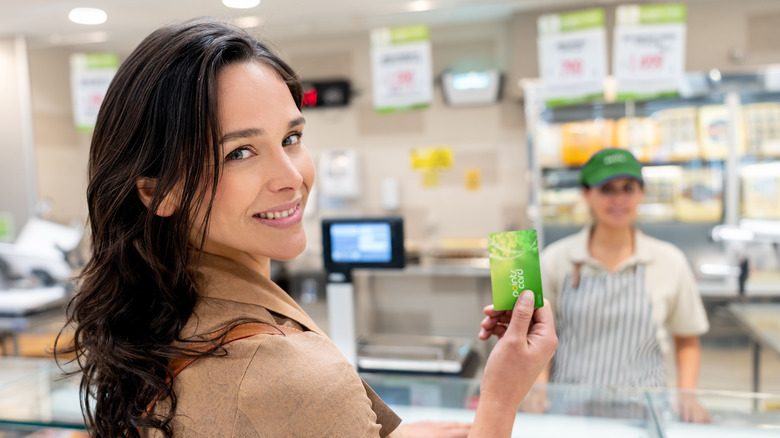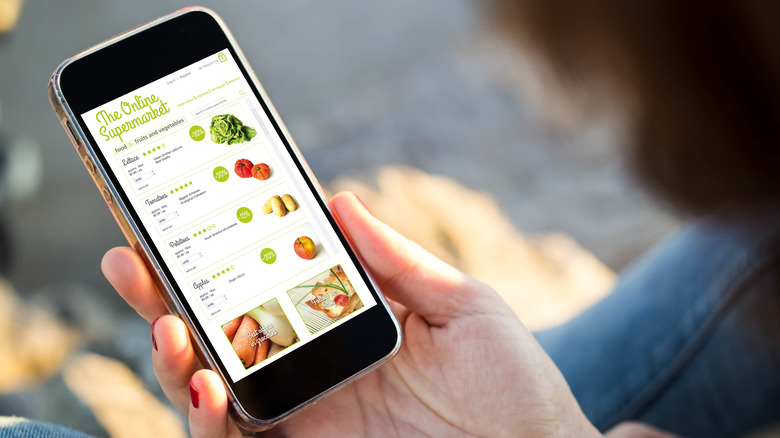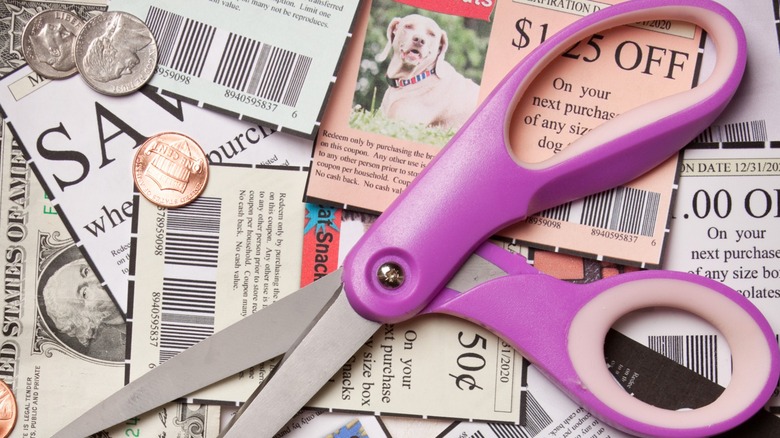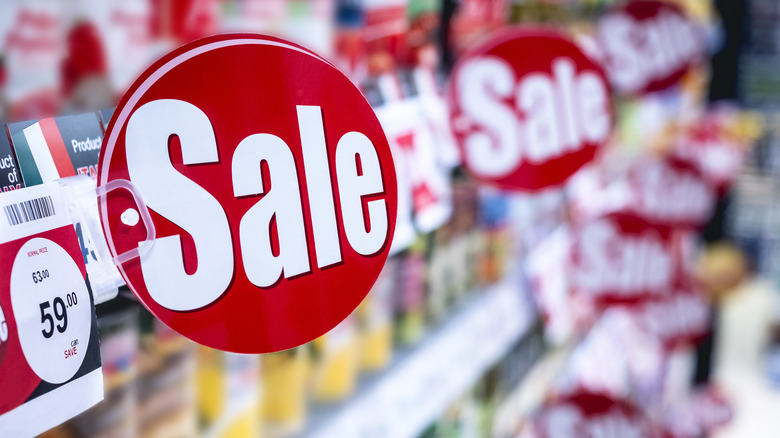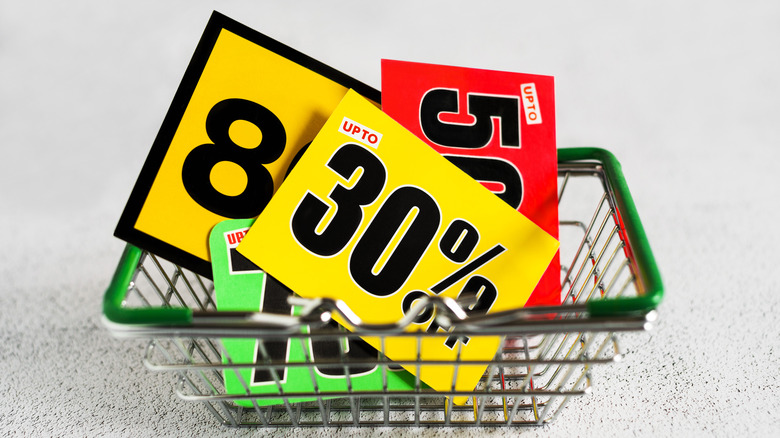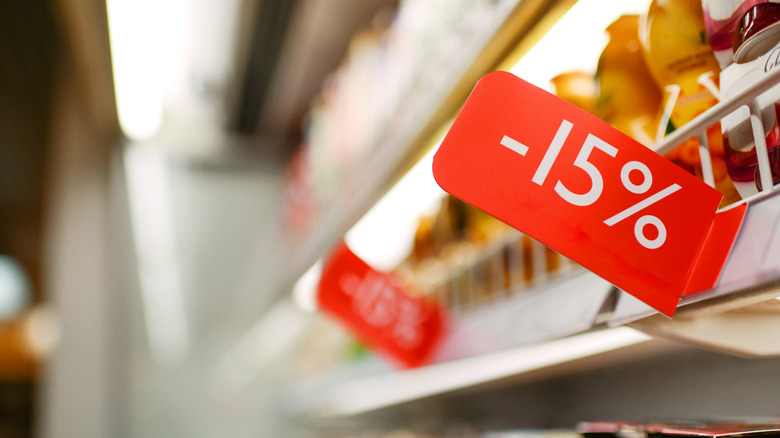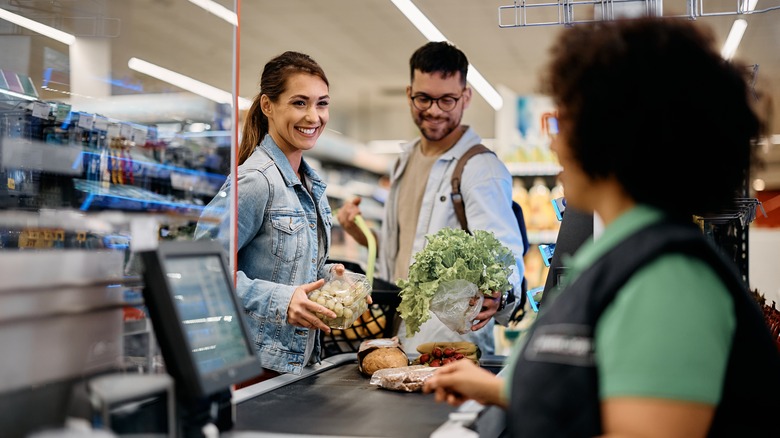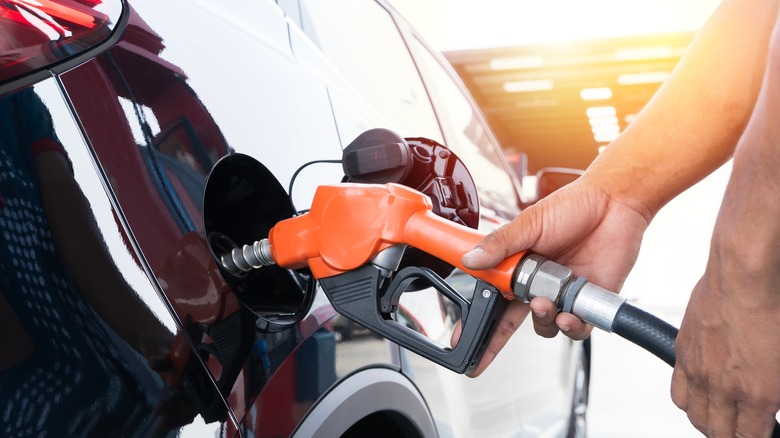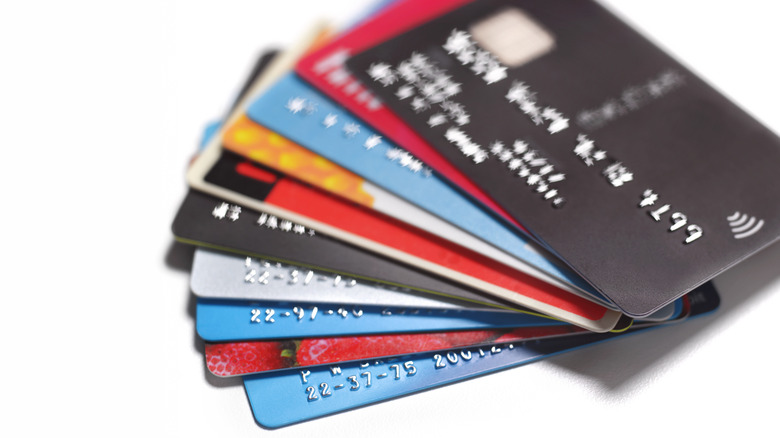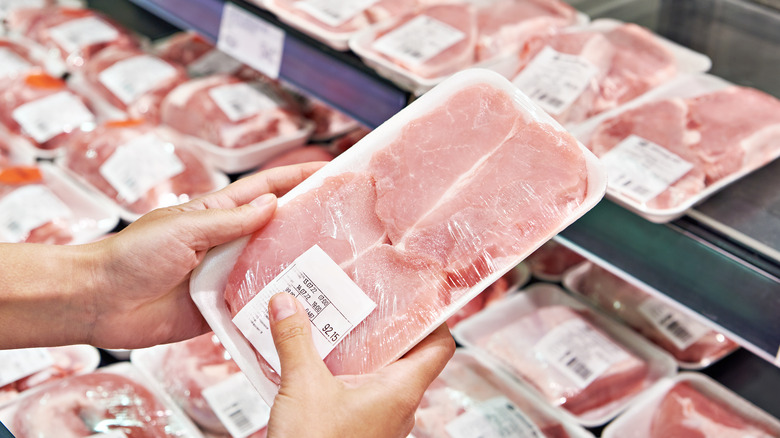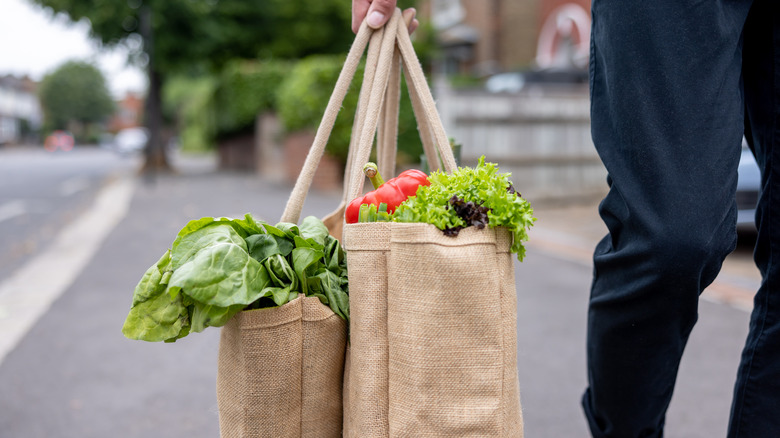The Secret Grocery Store Hacks Every Shopper Needs To Know
The higher grocery prices go, the more necessary it becomes for shoppers to use every trick in the book to save as much money as possible. This means hauling out the secret hacks that may not be top-of-mind when you hit the store with your list. To give you an edge during future shopping trips, we cranked the old mind machine, did a little research, and assembled a list of the grocery store hacks you need to know to keep the damage to your debit card as contained as possible.
Do you check your receipts to make sure you've been charged properly for sale and markdown items? Are you using loyalty cards and discount apps to maximize your savings? From easy strategies like using paper coupons, to slick tricks like angling for discount combinations, this array of clever approaches provides a hefty haul of helpful hacks to make sure you get your money's worth every time you load your cart. Adopting just a few of these practices can prevent needless grocery store mistakes, while keeping cash in your pocket.
Loyalty cards can multiply your savings
By now, the average grocery shopper is aware of the free loyalty cards promoted by big-name grocery chains around the United States. They're advertised as a program in which you hand over your contact info and enjoy storewide savings on your favorite brands. It can sound invasive at first, but once you acclimate to the benefits of joining a loyalty program, it turns out to be one of the easiest and most effective ways to give your food budget a substantial stretch. Albertsons' Just For U program offers shoppers one point for every grocery dollar spent, two points for every gift card dollar spent, and point multipliers that translate into additional points, all of which count toward discounts on future purchases.
Opting for the basic program is enough to start earning savings on grocery items, fuel, and home delivery charges. But add-ons like Kroger's Boost program can help you save even more. This elite-level loyalty comes with a price tag of $59 per year after a free trial period. However, with a bit of diligence, frequent shoppers can more than earn back the fee. Even if you shop without the card on hand, entering your phone number will connect your purchases to your account, so you can rack up the savings without having one more piece of plastic to lug around. Programs vary, of course, so be sure to research which might work best for your needs.
Using store apps is an economical choice
Larger grocery retailers push their savings apps to help both themselves and shoppers, by arranging specialized deals based on customer-specific shopping habits. On these apps, certain coupons, bonuses on fuel points, cash-back offers, and discounts on multiple purchases appear as personalized specials aimed at the products you buy most frequently. These apps are also handy for organizing your weekly shopping list by coupon, sale, and special discount to make sure you don't miss a savable cent. You'll also find rebates tailored to your purchasing habits, something not available without the app. And, if keeping track of too many apps seems like a time suck, combine them through a service like NerdWallet to track all of your discounts in one place.
A word of caution: Using the app doesn't always mean automatic savings for these premium deals. Some store apps — like the ones used by Albertsons and Safeway — require you to check the item on discount and add it to your shopping list in order to receive the savings at the register. Be sure you know how the game works so you can use the rules to your advantage.
Paper and digital coupons can provide you great deals
Ah, the charm of sifting through old-fashioned paper coupons in the Sunday paper to find treats and treasures for your shopping trips! While the popularity of physical newspapers may have diminished in recent years — thanks, internet — you can still access the coupon section with special subscriptions dedicated just to the discount pages. Some dollar stores offer the Sunday edition as a stand-alone item, a buy worth grabbing for the cash-ready coupons nesting at the center. And those coupons that print out with your receipt are usually related to your purchases, giving you yet another avenue to explore for keeping more of your money in your piggy bank. With potential savings of hundreds to thousands of dollars per year, coupons are a cash cow you should have in your shopping stable.
And here's a hack-within-a-hack: combining sales, coupons found on grocery store apps, and paper coupons can sometimes result in compound savings. True pros at making the grocery shopping savings game work to its fullest keep track of all three, plus in-store specials to make the reductions to their bill even more exciting. And you thought paper coupons were just good for lining your birdcage!
Shopping on Wednesdays gives access to new sale items
Knowing that major grocery retailers set their new sales on Wednesday mornings is key in planning your week's shopping. Though a midweek trip to the market may seem like just another task on a daunting to-do list, it's the best way to grab the sale items while they're available. If you do happen to arrive after the goods have been gotten by other shoppers, be sure to come back later, so you can pay the lower price when items have been restocked.
And, for a boss-level hack, know that Sprouts Farmers Market actually offers prices for both the previous week's sale and the coming week's sale on Wednesdays. This makes it the perfect day to take advantage of both sales' low prices without having to make two trips! With a little forethought, you could tackle two weeks' worth of shopping in one visit — and save money on gas, too.
Clearance products are usually just as good
Often, you'll find clearance and full-priced versions of the same item sitting side by side. The difference between them is usually the use-by date, which matters less with fresh items like produce and dairy (if you intend on using the items right away).
fDiscounts on bread can be 50% or more, substantial savings that could go unnoticed if you aren't checking for the sticker. Some retailers like Grocery Outlet are dedicated entirely to closeouts and clearance goods, items that are still consumable but have lost their popularity or been demoted from their shelf space in larger retailers. In contrast to low-priced chains like Aldi, where well-known items and Aldi-specific items share the shelves, these outlets carry a blend of national brands and store-branded items from a variety of chains, giving you access to the wide world of markdown groceries in a single space.
A word of caution: Be highly alert when shopping for clearance meats and poultry and check the best-by dates very carefully to avoid wasting money on meat that may become inedible quicker than anticipated. Many times, you'll find more than one date represented among similar items. Giving them a careful read can save you time on making a return trip for a refund, and it will definitely keep you from inadvertently purchasing food you can't use.
Checking shelf tags can reveal unadvertised sale items
Shopping for markdowns all around the store yields treasure you wouldn't ordinarily know to look for. Many chains allow managers of individual store locations to mark down items specifically at their discretion (usually due to them being overstocked or slow to move). These items aren't always called out with a big yellow sign or an end cap display — like they are at Kroger grocery stores — but you can usually find a shelf tag that alerts you to the savings. Spying these extra savings is an expert-level grocery savings hack worth checking out. You may find items you buy regularly are suddenly marked down for a specific time frame, like after peak holiday shopping.
How much can you expect to save with in-store specials? Sometimes, it's a few cents, while other times it can be a substantial percentage of the regular price. And it may not be every item in a particular product line. A candy bar brand flavor that isn't selling as well as expected may be the only selection marked down. Start looking for these specials and watch your savings grow!
Price matching is honored at many grocery stores
Do you use your smartphone to zero in on the lowest prices for the items you shop for the most? If not, you could be cheating yourself out of grocery store price-matching discounts. This helps you locate the best price possible at grocery stores, even if you don't consider them the best grocery store in your area. Loyalty to your budget tops loyalty to your favorite chain, hands down.
Walmart has a policy of matching the lowest competitor price on the items they sell, which lets them keep their guests happy while ensuring customers keep shopping in their store. Target has a similar policy that gives shoppers up to 14 days after their purchase to find a lower price. That price can be found on the Target website, a competitor's website, or on a competing store's advertisement.
If shopping like this isn't for you, checking sale prices the following week for full-priced items purchased at your dedicated retailer can lead to unexpected savings. Many retailers allow customers a refund on the difference, as long as the sale has occurred within a certain period. Don't be afraid to ask customer service if you happen to see last week's purchases in next week's ad!
Bonus fuel point days can make a huge difference
Gas may not count as a grocery. But with many retailers connecting their chains to fuel stations, it's a related purchase that can help you save money, thanks to fuel points. For instance, Kroger's shopper loyalty program designates Fridays as 4X Fuel Points days, which means every dollar you spend quadruples your discount on gas purchased at their fuel stations. This can lead to wild savings for frequent shoppers, sometimes discounting as much as 85 cents per gallon. The chain also runs fuel points bonus specials on gift card purchases, a perk you can easily put into action for any gift-giving occasion on the horizon. Albertsons also offers fuel points, as every 100 points earned through grocery purchases means 10 cents off each gallon, for up to a full dollar off per gallon.
Managing your grocery-to-fuel savings can be a bit tricky. Fuel points earned in the current month may not be available to use until the following month, so be sure to verify your point usage to make sure you're getting the discount when you expect to. But with a little planning ahead, you'll have even more money in your account!
Using a store credit card yields you points and cash back
It's worth checking into store-based credit cards, as they will put even more cash back in your pocket on your grocery excursions. Luckily, Kroger offers a credit card that will turn your purchases into cash that you can use on groceries or paying your bills. Perks for the Kroger credit card vary based on where you shop, what you buy, and whether you use your card or Kroger Pay through the store app. But with a little strategic shopping, you can make a plan that works best for you.
You'll also be maximizing your fuel savings every time you use your card. Depending on your shopping volume and frequency, you may save hundreds of dollars in the course of the year. There's also no annual fee with the Kroger card. When you fine-tune the process, an in-store credit card like this can translate to money in the bank. If you already have a credit card that offers cash back or points for purchases, you can maximize your returns by using the card to buy groceries and pay off your total.
Returning spoiled items may be more lucrative than tossing them
When finding you've purchased out-of-date yogurt or gone off produce when you get your groceries home, it's tempting to just throw them away and move on. But returning the items not only keeps your spending-to-wasting ratio in check, but it may also increase your cash flow.
Kroger's return policy provides a 30-day window from the purchase date to make your returns, even without a receipt. Albertson's allows 90 days for customers to return store-branded items due to dissatisfaction for a 100% refund. Whole Foods also gives 90 days for returns. Publix doesn't specify a time frame for its refunds. Food Lion stores will give you double the price you paid when you return private-brand or in-store department fresh food items if you're not satisfied with your purchase. Hold onto your receipt and settle up next time you're in the store.
It's tempting to scorn your favorite grocery store for stocking past-due products among the fresher fare — customer safety should be concern number one for a food proprietor after all, so this can feel like your shop is cutting corners. But remember how much food is stocked in the fresh sections and how much labor is involved in making sure it all gets turned over on time. Though your hope for fresh food every time is reasonable, knowing that it doesn't always happen that way can save you time, money, and frustration (a triple-win any smart shopper would value).
Checking your receipt is crucial
It's easy to fly out of the store assuming every discount you expected rang up in the register properly. But there are frequent issues with pricing that can result in you missing out on the very sale prices you were shopping for. Audits on store register systems have revealed massive mischarges for chains like Safeway, one such retailer we all depend on to be fair and accurate with their pricing practices. Rack up enough errors and the shopping public is looking at billions of dollars in overcharged grocery purchases, and some of that money belongs to you!
You may be powerless to change your store's point-of-sale system, but checking your receipt while you're still in the store lets you address the issue of overcharging yourself. If you notice a charging error, swing by the customer service counter, point out the issue, and you should receive the difference in cash or back on your card instantly. If you return home and find your receipt doesn't match the expected prices, you should always take the receipt back to the store to point out the issue and request a correction — preferably in the same week as the effective price difference. You don't even have to bring back the item; the store should know based on register records that the item rang up incorrectly.
Bringing reusable bags will help you save money
With every city, state, and grocery retailer holding a different policy on single-use plastic bags, having your own reusable bags on hand can save you money while helping minimize waste. Stores like Sprouts are phasing out plastic in their stores, anticipating a savings of more than 200 million bags yearly. Stores in states like Colorado even charge you per bag used if you don't bring your own, incentivizing the reduction of unnecessary plastic usage. You can even bring smaller bags to catch your produce purchases in and avoid using endless rolled plastic bags which, let's face it, never come off the roll easily anyway. Who needs that kind of hassle in their shopping life?
A dime a bag may not seem like much, but if you shop weekly for your family, it may be a dollar spent on bags that you just don't need to shell out. Why not invest in reusable bags to keep your money in your pocket and your planet in better health? Keep them in your car either stashed under the seat, in the side compartment, or in your trunk so they're out of the way. Grab them on your way in and leave the plastic bags on the rack in favor of a sturdier sack. It's a hack that helps with more than just your grocery bill!

